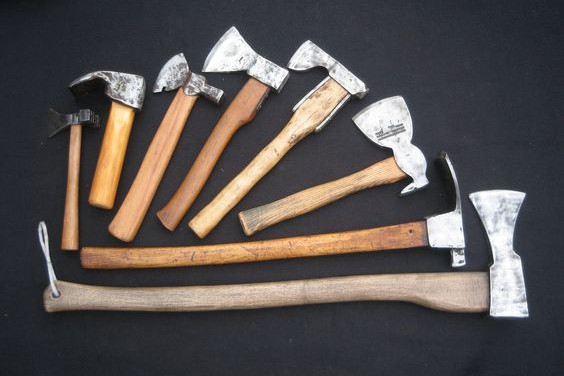Axe vs. Hatchet: Do You Know The Difference?
TheToolGeeks.com is a participant in the Amazon Services LLC Associates Program and other affiliate advertising programs. We may earn from qualifying purchases. (Learn More).
One of the best tools ever invented has got to be the axe. People have been using axes for eons. The first hand-made axes date back thousands of years to the Mesolithic period (ca. 6000 BC). They continue to be indispensable tools for various woodworking projects and tasks today.
Primarily, axes are used for cutting down trees, making kindling, and cropping wood logs. But did you know that there are different types of axes?
Let Me Explain.
Axes, hatchets, and tomahawks are common wood-chopping equipment. Many people get confused and think these similar tools are the same, but they’re not. Although they may appear alike, they have distinct and separate functions.
If you’re about to tackle a woodworking project and are considering an axe, hatchet, or tomahawk—which one should you buy, and why? Buying the wrong tool may put you and the project in danger or risk your safety. Plus, if you purchase the incorrect tool for your job, it may contribute to the tool breaking, you getting hurt, the project being destroyed, or your wasting time and not achieving your desired result.
This is why it’s so important to understand the differences between an axe and a hatchet. In this article, we aim to archive the following:
- Define what axes and hatchets are
- Identify the differences between axes and hatchets
- Help you understand which option is the right tool for your needs
Jump To Page Contents:
What’s an Ax?
An axe is a cutting tool consisting of a heavy, sharp-edged head usually crafted from iron, with a steel edge, and fixed at a right angle to a handle. The blade edge is parallel to the wooden handle. Axes are mostly used for felling trees and chopping and splitting wood. A simple definition? Think about a long-handled hammer with a blunt, cutting edge.
An axe is a simple tool that reduces the effort required to split wood into two pieces. It cuts wood using the pressure concentration at the blade’s edge to sever wood into pieces. The handle acts as a lever, allowing the user to put power and energy behind each blow, making cutting and chopping more efficient.

There are various types of axes on the market, with different manufacturers claiming their product is the best. However, most of these axes could be of better quality. To help you select the best one, it’s critical that you must understand the requirements of your task–and the qualities of the axe you’re considering purchasing.
Different axes work well for different and diverse jobs. There are splitting, carpenter’s, double-bit, throwing, and Viking axes–each one works best for specific tasks.
Here’s a look at the differences between these three main types of axes:
- Double-Bit Axes – Much like normal, single-bladed axes, double-bit axes instead have two blades–one at each side of the axe head. Check our list of the best double-bit axes.
- Throwing Axes – Most commonly used for competitions, throwing axes are best used when users are participating in an axe-throwing competition. Learn more about throwing axes.
- Viking Axes – Popular for decorative use, Viking axes aren’t usually suitable for woodworking projects. They’re made mostly for design purposes and don’t come with a low-quality head/blade. Find out more about the best Viking axes.
How Do I Choose an Axe?
As mentioned earlier, to select the best axe for your job, you’ll need to understand your project requirements. Also, your physicality may also weigh into what type of axe you should select. Studying up on what’s available, and researching your project, can help you collect the proper resources to inform the best decision.

With different manufacturers offering separate features, and some product traits doing more harm than good, there’s a lot to consider. That’s why we collected a list of five things you’ll need to consider and what to look for when deciding on which axe you’ll purchase.
Read also: Best Carpenters Axe: Reviews & Buyers GuideBlade Material
As the main cutting part of the axe, the blade quality is essential. A good axe will easily cut down the wood and may require a fair amount of strength. A good blade can help make the act of cutting through wood easier for you. Axe blades are available in different materials, and it’s best to select ones that have blades made from steel, iron, or carbon steel. (Avoid buying an axe with a blade made of plastic or any other material as it can bend easily.) Steel, carbon steel, and iron are all good materials that can help ensure your axe blade will be durable and long-lasting.
Handle Material
The axe handle must be durable and comfortable in order to be effective. You don’t want an axe that will break or lose its value by wearing out, right? Of course not! That’s why you must choose an axe crafted from high-quality handle materials.
A good axe generally will have a handle made from hickory (known as being the best choice for wooden axe handles). Steel axe handles are another good choice and can offer lots of durability.
Non-Slip Handle
You do not want a slippery axe handle. Smooth handles may become dangerously slippery when your hand’s sweat and are a big NO when it comes to axe shopping. Your best option, for safety and effectiveness, is to look for an axe with a non-slip grip and materials and a wider bottom at the base of the handle. All these traits are important to consider; because you don’t want your sharp axe to slip from your hand while working!
If by chance you already have an axe in your garage or tool shed with a smooth handle, you can sand it down a bit. This will help you rough up the surface of the wood to reduce the chances of it slipping from your hands during use.
Handle Length
Handle length is another critical part of a well-designed axe. Axes with a longer handle are preferred over those with shorter handles. If you’re working on a big project, such as cutting down trees, you’ll need a handle with a decent length to help you bring more power to your axe blows. But if you’ll be using an axe for a small project–such as cutting kindling–a short handle will work just fine. (You just may have to use a bit more energy and power.)
Handle Orientation
Although this isn’t as important as the other traits, the shape of your axe’s handle is still worth consideration. Most axe handles can come in two forms: A straight handle (with no curvature between the axe head and the handle bottom or base), or a curved handle (usually with a curve towards the bottom or base of the handle). Studies have shown that the curved handle works better with double-bit axes, and the straight one works best with single-bit axes.
What’s a hatchet?
In many ways, such as the design, the hatchet looks like an axe. However, both are suited for separate woodworking projects.

A hatchet is designed for lighter work and has a handle half the length of an axe. It is just a smaller version of the axe. Most professional roofers, carpenters, or campers use hatchets.
To find the best hatchet, you should consider the same qualities you would when selecting good axes: Materials, weight, and blade quality, plus the handle length and materials, too.
What are the differences between Axes and Hatchets?
There are six main differences between an axe and its smaller cousin, the hatchet.
- The blade. A hatchet, by design, is much like an axe–but has a hammerhead blade. An axe does not.
- Size. The hatchet is a smaller version of the axe.
- Tasks and usability. While the axe is used to chop down big trees and hardwood, the hatchet is used more for smaller tasks.
- Weight. The hatchet is lighter. It can still be used to cut logs, but its V-tapered head is more suited to splitting kindling, chopping smaller logs, or hewing logs into thin strips.
- Cost. Axes tend to cost more than hatchets due to more materials being used and their larger size.
- Versatility. A hatchet, with its smaller size, hammer-like head, and shorter handle can be a more versatile tool–used for more than just cutting wood.
Hopefully, this article has helped clear up the differences between axes and hatchets–and given you a better understanding of their similarities and differences. If you’re curious to learn more about hatchet options, read about our best kindling hatchets.
See also:
Amazon and the Amazon logo are trademarks of Amazon.com, Inc, or its affiliates.

